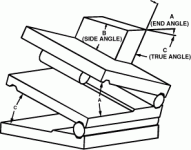Parkerbender
Stainless
- Joined
- Dec 19, 2009
- Location
- Kansas City Mo, USA
I knew I should have paid better attention in school... Ha.
Anyway,
So I have a part that needs tipped left 3.1716 degrees, and tipped back 2.777 degrees, and I am trying to add the angles so I can program this as a 3d cut on my mill as one 'x-z' angle, translated in 'y' but rotated at an angle about the c axis. Does that made sense? I can't remember even what the damn math procedure is called to relearn it, I believe we were doing this with a unit circle in school, but I start thinking and then my thermal overload trips in my head...
Anyone remember how to do this?
Thanks for any help at all!
-Parker
Anyway,
So I have a part that needs tipped left 3.1716 degrees, and tipped back 2.777 degrees, and I am trying to add the angles so I can program this as a 3d cut on my mill as one 'x-z' angle, translated in 'y' but rotated at an angle about the c axis. Does that made sense? I can't remember even what the damn math procedure is called to relearn it, I believe we were doing this with a unit circle in school, but I start thinking and then my thermal overload trips in my head...
Anyone remember how to do this?
Thanks for any help at all!
-Parker




